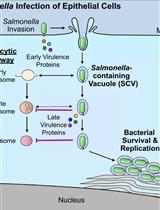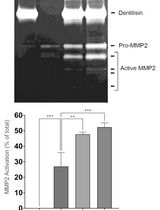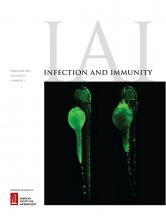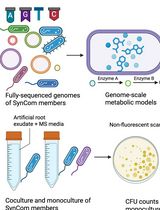- EN - English
- CN - 中文
Zebrafish Bacterial Infection Assay to Study Host-Pathogen Interactions
斑马鱼细菌感染检测用于研究宿主-病原相互作用
发布: 2020年03月05日第10卷第5期 DOI: 10.21769/BioProtoc.3536 浏览次数: 5136
评审: Lokesh KalekarPooja SaxenaSvetlana Kurilova

相关实验方案

细菌病原体介导的宿主向溶酶体运输的抑制:基于荧光显微镜的DQ-Red BSA分析
Mădălina Mocăniță [...] Vanessa M. D'Costa
2024年03月05日 2845 阅读

通过制备连续聚丙烯酰胺凝胶电泳和凝胶酶谱分析法纯化来自梭状龋齿螺旋体的天然Dentilisin复合物及其功能分析
Pachiyappan Kamarajan [...] Yvonne L. Kapila
2024年04月05日 2003 阅读
Abstract
The study of host-pathogen interactions has improved our understanding of both pathogenesis and the response of the host to infection, including both innate and adaptive responses. Neutrophils and macrophages represent the first line of innate host defense against any infection. The zebrafish is an ideal model to study the response of these cells to a variety of pathogens. Zebrafish possess both neutrophils and macrophages exhibiting similar defense mechanisms to their human counterparts. The transparency of zebrafish embryos greatly facilitates in vivo tracking of infection dynamics in a non-invasive manner at high-resolution using labelled pathogens, while immune cells can also be labelled transgenically to enable even more in-depth analysis. Here we describe a procedure for performing a bacterial infection assay in zebrafish embryos using fluorescently-labelled E. coli bacteria and demonstrate the monitoring and quantification of the infection kinetics. Of note, this procedure helps in understanding the functional role of genes that are important in driving the innate immune response.
Background
Host-pathogen interaction studies are important to understand disease pathogenesis and also for the development of effective treatments. Multiple aspects of both the host and pathogen need to be considered to determine potential risk factors in the host and key virulence factors in the pathogen. Innate immunity represents the first line of defense against infections, triggering a cascade of responses, including inflammation, neutralization and recruitment of components of the adaptive immune system (Akira et al., 2006). Neutrophils are rapidly recruited to the site of bacterial infection in response to chemoattractant gradients of host chemokines released from damaged cells as well as bacterial products themselves, where they initiate the immune response by phagocytosis and netolysis (Renshaw and Trede, 2012; Deng et al., 2013). Macrophage recruitment follows, with these cells focused on removing dead cells, remodeling injured tissue and coordinating adaptive immune cells (Weiss and Schaible, 2015).
The development and function of innate immune cells are controlled by a range of specific genes, the dysregulation of which can lead to a number of pathological states, including enhanced susceptibility to infection and chronic inflammation. Being short-lived, neutrophils are depleted rapidly in response to exposure to a pathogen, with so-called ‘emergency granulopoiesis’ being initiated to generate additional neutrophils (Hall et al., 2012; Manz and Boettcher, 2014). Granulocyte colony-stimulating factor (G-CSF) acting via its receptor, G-CSFR, is a key mediator of emergency granulopoiesis through its action promoting the proliferation and differentiation of relevant hematopoietic progenitor cells (Panopoulos and Watowich, 2008; Liongue et al., 2009). Understanding the role of factors that regulate the innate immune response during bacterial infection in an appropriate in vivo model can provide unique insights into infection and immunity.
Zebrafish represents a very attractive in vivo model to perform host-pathogen studies, with its transparent embryos allowing in vivo imaging at high-resolution to track infection in real-time, by tagging the pathogens with fluorescent markers (Basheer et al., 2019). In addition, using transgenic approaches in zebrafish, neutrophils and macrophages can also be monitored via fluorescent tags (Ellett et al., 2011; Gray et al., 2011). Importantly, these cells along with other components of the immune system share remarkable similarity with those of humans (Meeker and Trede, 2008). The zebrafish innate immune system forms early during their development with the generation of macrophages at 24 h post fertilization (hpf) and neutrophils by 32-48 hpf (Herbomel et al., 1999; Willett et al., 1999; Bennett et al., 2001). The zebrafish adaptive immune system develops later, allowing the innate immune system to be studied independently. Zebrafish infection models of different pathogen–bacterial, viral and fungal–have been established (Gratacap and Wheeler 2014; Masud et al., 2017; Varela et al., 2017).
Our research has employed a zebrafish bacterial infection model to understand the role of key genes involved in innate immunity in defense against infection. Escherichia coli (E. coli) bacteria expressing green fluorescent protein (GFP) were microinjected into 72 hpf larvae derived from either wild-type zebrafish or those mutant for the gene encoding G-CSFR (Figure 2). These were monitored by fluorescence microscopy over a time-course to determine the relative infection kinetics (Basheer et al., 2019). Overall, this procedure helps in understanding different host-pathogen interactions and unravel the functions of key immune genes involved in the process using zebrafish as an animal model.
Materials and Reagents
- Transfer pipette, 3 ml (Heinz Herenz, catalog number: 1131303 )
- Mesh strainer, 12-15 cm in diameter (pore size should be less than zebrafish embryo with chorion diameter, approximately 0.5 mm mesh)
- Petri plate (PLP, catalog number: S9014UV20 )
- Parafilm
- Thin-wall borosilicate with filament, 1.0 mm x 0.78 mm x 15 cm (SDR Scientific, catalog number: 30-0039 GC100TF-15)
- Microloader pipette tips (Point of Care Diagnostics Pty Ltd, catalog number: EPP5242 956.003)
- Corning square dish, 245 mm Non-Treated (Corning, catalog number: 38020 )
- Paper towel
- Multiwell tissue culture plates, 6-well and 12-well (Interpath, Greiner, catalog number: 657160 , 665180 )
- Cuvettes (Bio-Rad, catalog number: 2239950 )
- Breeding/mating tanks, 3 L (Techniplast)
- Zebrafish (Danio rerio), wild-type
- E. coli-GFP bacteria (ATCC, catalog number: 25922GFP )
- Agar bacteriological grade (Astral Scientific, catalog number: J637-500 )
- N-phenylthiourea, PTU (Sigma-Aldrich, catalog number: P7629-10G )
- Benzocaine (Sigma-Aldrich, catalog number: E1501-100G )
- NaCl (Astral Scientific, catalog number: 0241-5kg )
- KCl (Sigma-Aldrich, catalog number: P9541-500G )
- CaCl2·2H2O (Sigma-Aldrich, catalog number: C3306-250G )
- MgSO4·7H2O (Sigma-Aldrich, catalog number: 63138-1KG )
- Methylene blue (Sigma-Aldrich, catalog number: M9140-25G )
- NaOH
- Phosphate buffered saline-PBS tablets (Astral Scientific, catalog number: AME404-200TABS )
- Triton X-100 (Sigma-Aldrich, catalog number: X100-500ML )
- Blu-tack
- BD BactoTM Tryptic Soy Broth (Soybean-Casein Digest Medium) (Becton Dickinson, catalog number: 211825 )
- Ampicillin, 100 mg/ml, ready-made solution (Sigma-Aldrich, catalog number: A5354-10ML )
- Milli-Q or distilled water
- Phenol red, 0.5%, liquid, sterile-filtered (Sigma-Aldrich, catalog number: P0290 )
- Mineral oil (Sigma-Aldrich, catalog number: M5904-5ML )
- 60x E3 media (see Recipes)
- E3 media (see Recipes)
- Methylene blue stock solution (see Recipes)
- E3 containing 0.3 mg/L methylene blue (see Recipes)
- PTU stock, 0.3% (w/v) (see Recipes)
- E3 containing 0.003% (w/v) PTU (see Recipes)
- Benzocaine stock solution (see Recipes)
- 10x PBS stock solution (see Recipes)
- PBS (see Recipes)
- 1% Triton X-100 in PBS (see Recipes)
Equipment
- Glass bottles, 1 L and 2 L
- Magnetic stir bar–PTFE Cylindrical 15 mm length x 6 mm diameter (PLP, Cowie, catalog number: 001.115.6 )
- Eppendorf tube racks
- Pipettes, 100-1,000 μl, 20-200 μl, 2-10 μl, 0.5-2 μl
- Watch makers forceps, pointed tweezers, style 5, 114 mm (ProSciTech, catalog number: T65-SA )
- Incubator, 28 °C (Sanyo, catalog number: MIR-162 )
- Incubator, 37 °C (Thermo Scientific, Hereaus, catalog number: B6030 )
- Shaking incubator (200-225 rpm) (Infors HT Multitron Standard incubator)
- Spectrophotometer (Bio-Rad SmartSpec Plus Spectrophotometer, catalog number: 273BR03695 )
- Micropipette needle puller (Sutter Instrument, catalog number: P-97 )
- Bunsen burner
- Atherton Chipmunk Autoclave Sterilizer
- Pipette pump
- Mini centrifuge (Thermo Fisher Scientific Pty Ltd, catalog number: 75004061 )
- Microcentrifuge (Thermo Fisher Scientific Pty Ltd, catalog number: THR75002410 )
- Magnetic stirrer (Ratek Instruments Pty Ltd, catalog number: MS10 )
- Refrigerator, 4 °C
- Microinjector set up (SDR Clinical Technology, Nanoject II Nanoliter In Jecto, catalog number: 690131 , Footswitch, catalog number: 690140 , Support Base, catalog number: 690141 , Micropipette Holder Kit Option, catalog number: M-PIP-Kit )
- Stereo dissecting microscope with light base (Nikon, catalog number: SMZ745 )
- Fluorescence microscope (Olympus, model: MVX10 with DP72 camera)
- Tissue Lyser II (Qiagen, model: 85300 )
- Fume hood
Software
- GraphPad Prism 8 (http://www.graphpad.com)
- ImageJ (https://imagej.nih.gov/ij/index.html)
Procedure
文章信息
版权信息
© 2020 The Authors; exclusive licensee Bio-protocol LLC.
如何引用
Basheer, F., Liongue, C. and Ward, A. C. (2020). Zebrafish Bacterial Infection Assay to Study Host-Pathogen Interactions. Bio-protocol 10(5): e3536. DOI: 10.21769/BioProtoc.3536.
分类
免疫学 > 宿主防御 > 综合
微生物学 > 微生物-宿主相互作用 > 细菌
细胞生物学 > 基于细胞的分析方法 > 细菌感染
您对这篇实验方法有问题吗?
在此处发布您的问题,我们将邀请本文作者来回答。同时,我们会将您的问题发布到Bio-protocol Exchange,以便寻求社区成员的帮助。
Share
Bluesky
X
Copy link












